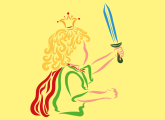Jane Newberry explains why playful poetry is so engaging for young children…
Children at a primary school come in for a poetry workshop. Faces are curious, fearful, uncertain, defensive, expectant, too cool for school, watchful and wary.
What is this thing, poetry? Will it be hard or make me look silly? Will it be scary/weird? Is it safe? I dive straight in, no intros, and I watch the fears and apprehension fall away.
I’ve dedicated a very large portion of my life to producing poetry that anyone can do, however uncertain they are, whatever their special need. I aim to break down barriers of mistrust in learning.
Part of my USP as a children’s poet is where I began: with writing songs. I write simple join-in, jam-along songs, which I published under the banner “playsongs”. (A Sackful of Songs, Cramer Music 2005).
And it is the playing that we need in early years. Children need to be free to play and to be educated through playful concepts.
By joining in with a song taught aurally, children access their own rhythmic skills, those built into everyone’s DNA.
Mankind almost certainly sang for ritual, for reassurance, for pleasure long before we wrote words down.
In today’s primary settings, some teachers are uncertain about leading singing activities. However, singing and performing poetry “out loud” is important for children’s general wellbeing as well as specific developments within the curriculum.
Play-rhymes fit very well within a programme of playsongs and percussion games. Variety keeps up concentration levels, which may fluctuate in EYFS. I always keep each separate song, poem or exercise very short and playful.
Back when I was teaching traditional nursery rhymes and songs for two or three years, I was painfully aware that many rhymes were becoming archaic. Not many Little Boy Blues were blowing their horns. There were not many forlorn shepherdesses in suburban Kingston-upon-Thames.
Children like singing about things they understand and know, like food, dinosaurs, monsters, teddies, etc.
My first attempts at rhyme were trialled by real children in parent/toddler groups. Over the years I have dropped songs and rhymes if parents or children didn’t rave about them or found them hard. Things have to work.
Here’s a children’s poem written in 2004, for which I produced illustrations showing the actions:
This little chick climbed the hill so steep when he got to the top, he said, “Cheep, cheep, cheep!”
This little lamb said, “It’s very far …” When she got to the top, she said, “Baa, baa, baa!”
This little duck said, “I’m going back” When he got halfway… he said, “Quack, quack, quack!”
It was an easy transition from songs to play-rhymes. Steady rhythms that can be beaten with claves or clapped or tapped on knees were the foundation. What sounds a bit boring to adults is perfect for children.
I love to write rhymes with surprises, like animals popping up or out. These build a bit of “theatre” into a short poem.
It is a joy to receive videos from schools that show the imaginative ways children act out a short play-rhyme. While I enjoy the challenge of writing for adults, writing for the very young is still, after so many years, fun and exciting.
Children constantly bring me ideas as their minds expand on an idea I have planted earlier. My best song came about after gathering claves into a box. Two boys were being rather slow, and one had the claves on his head while the other copied him.
“What are you doing?” I asked. “Well, I’m a rabbit, and Luca is being a reindeer,” came the reply. The same inspiration has given me a great play-rhyme about aliens. Thanks Luis and Luca!
A great deal of emphasis is placed on the term “child-centred” in EYFS pedagogy. It is, of course, key to attracting children to learning.
So often, what is offered to children are smaller or watered-down versions of what works for grown-ups. And yet, children are not mini adults. They are children, full of wonder, mischief and fun.
Yes, they wear their emotions on the outside. However, having fewer inhibitions makes them much more responsive to the full range of the arts. This is a gift to the children’s poet.
You can guarantee your lions will truly roar, your dragons will flap their wings, and your snakes will hiss – and who knows what the dinosaurs will do!
Poems nourish children’s imaginations, and as development goals force them down specific pathways, I feel children’s writers must lure them off the beaten track to the wild places, the hidden valleys, the rocky deserts and out across the high seas.
Jane Newberry is a poet, children’s author and songwriter. She has been shortlisted for the CliPPA for her books Big Green Crocodile and Big Red Dragon (Otter-Barry Books). CLPE, the national centre for children’s poetry, offers practical support for teachers, including book recommendations, teaching sequences and CPD.

Why play is essential to early childhood development
Editors picks
